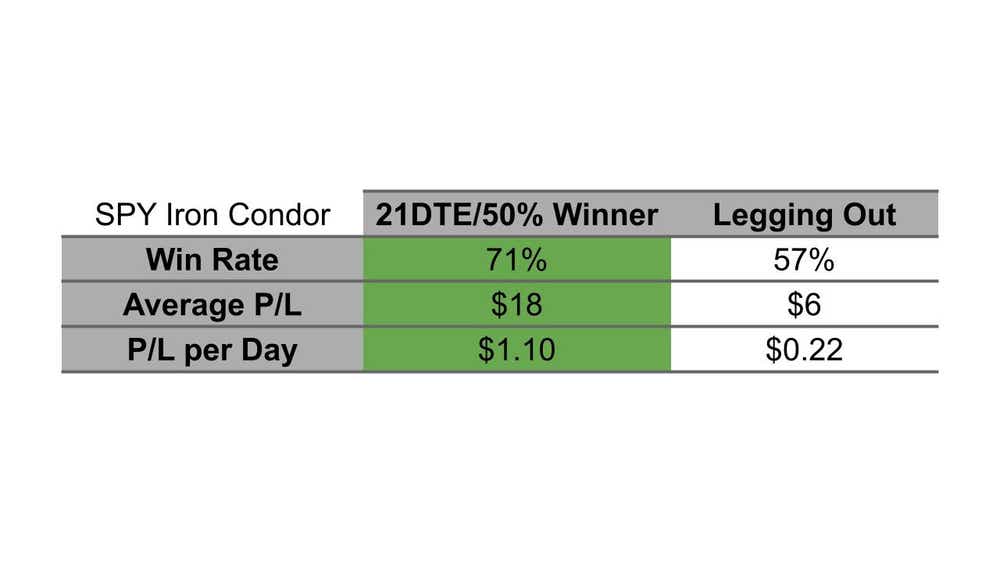Here's Why Legging Out of Iron Condors Can Backfire

Here's Why Legging Out of Iron Condors Can Backfire
By:Kai Zeng
To fully appreciate the potential costs of legging out of iron condors watch the tutorial video that has had more 230,000 views
- "Legging out" does not outperform a classic management approach.
- Instead, leads to a significantly lower success rate.
- Legging out unnecessarily extends the holding duration.
Options traders are often tempted by the practice of "legging out" of a position. This involves closing individual legs of the options strategy separately, typically a neutral strategy, rather than exiting the position, with the aim of increasing potential profits.
However, as we previously discussed in the article, Legging in Options Trading, we usually avoid legging out of naked positions such as strangles. This is because removing one side first exposes the position to unlimited or high risk on the other side, leading to increased P/L volatility and reduced profitability. But, what about risk-defined strategies like iron condors?
The put and call spreads on either side can limit the risk independently, so is it beneficial to exit one side first if it shows a significant profit?
To assess the effectiveness of this approach, two comprehensive studies were conducted. In both, we sold 45-day SPY 30 delta strangles and bought $10 wide wings.
First study
In the first study, we compared: Closing the position at 21DTE or 50% winners and legging out by removing individual spreads at 90% of max profit if possible.
The results were consistent with our observations in naked options. Rather than boosting profits, legging out led to a significantly lower success rate and average P/L per trade.
It also resulted in a substantial decrease in average daily P/L, suggesting that trades are being held longer, potentially tying up capital that could be used in other profitable trades. Interestingly, less than 2% of occurrences showed our 21DTE/50% winner management combo losing while the legging out strategy showed profits.
![[cost legging out 11]](https://images.contentstack.io/v3/assets/blt40263f25ec36953f/blta00e52eeeb602a70/64d53423cff7dffc85c57b9f/cost-legging-out-11.jpg?format=pjpg&auto=webp&quality=50&width=1000&disable=upscale)
Second study
To further verify our results, we conducted a second study comparing our classic 21DTE/50% winner approach to taking off individual spread if the opposing side’s option is breached.
Regrettably, legging out still did not outperform our classic management approach. The results were even worse across all metrics. This time, only 1% of occurrences showed our 21DTE/50% winner management combo losing while the legging out showed profits.

Manage your iron condors
In conclusion, while traders have numerous strategies at their disposal, it's vital to evaluate their effectiveness and potential risks. Like naked strangles, the studies presented here strongly suggest that legging out of an iron condor can pose more risk than reward.
We recommend that traders manage their iron condor positions, rather than legging out, to increase their chances of success. The action of legging out unnecessarily extends the holding duration, which cannot guarantee improved daily P/L.
And, we recommend that you watch this video to fully grasp these concepts:
Kai Zeng, director of the research team and head of Chinese content at tastylive, has a 20-year background in derivatives trading and market experience. He cohosts several live shows, including From Theory to Practice and Building Blocks. @kai_zeng1
For live daily programming, market news and commentary, visit tastylive or the YouTube channels tastylive (for options traders), and tastyliveTrending for stocks, futures, forex & macro.
Trade with a better broker, open a tastytrade account today. tastylive, Inc. and tastytrade, Inc. are separate but affiliated companies.
Options involve risk and are not suitable for all investors. Please read Characteristics and Risks of Standardized Options before deciding to invest in options.